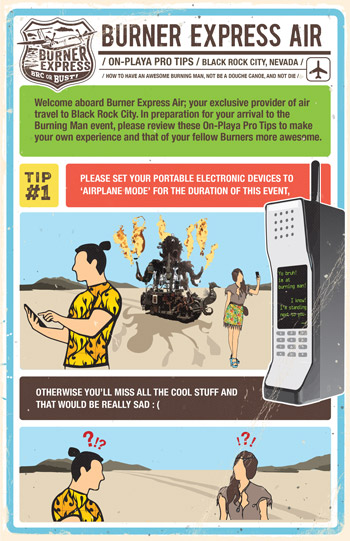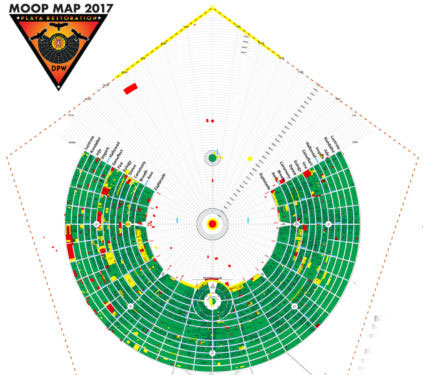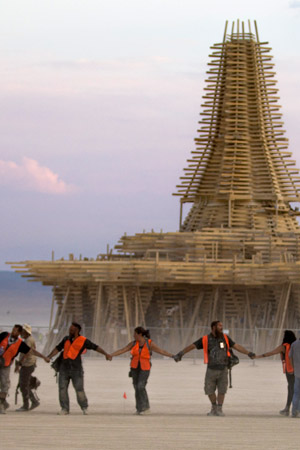 As an official reinvestment of our organization’s time and
energy, Project Citizenship kicked off at the 2017 Global
Leadership Conference. We used many channels to get key
messaging out to participants: videos that discuss Matter Out
Of Place (MOOP)/Leaving No Trace, best practices for getting
into and out of the city safely and sanely, and information
about the realities of providing emergency services in a city
as wild as Black Rock City. We sent targeted emails addressing
big themes like “Be kind to yourself and others,” and “Be
prepared”, we gave out sassy and informative acculturation
handouts on Burner Express Bus and Air, and more. While we
have many communications channels to reach participants, we
are also leaning on the community (particularly theme
camp/mutant vehicle leads, Regional Contacts, and other
leaders) to step it up, be good citizens, and bring their team
members into the fold.
As an official reinvestment of our organization’s time and
energy, Project Citizenship kicked off at the 2017 Global
Leadership Conference. We used many channels to get key
messaging out to participants: videos that discuss Matter Out
Of Place (MOOP)/Leaving No Trace, best practices for getting
into and out of the city safely and sanely, and information
about the realities of providing emergency services in a city
as wild as Black Rock City. We sent targeted emails addressing
big themes like “Be kind to yourself and others,” and “Be
prepared”, we gave out sassy and informative acculturation
handouts on Burner Express Bus and Air, and more. While we
have many communications channels to reach participants, we
are also leaning on the community (particularly theme
camp/mutant vehicle leads, Regional Contacts, and other
leaders) to step it up, be good citizens, and bring their team
members into the fold.
 In April and May, Placement collaborated with Playa
Restoration to call and email camp leadership of the 37 camps
with the worst MOOP score from 2016 (ranked on total number of
non-green square feet as well as camps who were >75% red).
The team from Placement and Resto shared Leaving No Trace
strategies with the camps, discussed specific camp issues, and
collaborated on concrete plans for how they could improve in
2017. They made fantastic improvements: In 2016, the worst
MOOP camps were on average 30% red, 25% yellow, and 45% green.
In 2017 these same camps were on average 7% red, 8% yellow,
and 85% green! Only three of the 37 camps substantially
worsened in 2017. Ninety-two percent improved. Placement
continued working with camps who need additional support and
cultural education to be more interactive, public, and
inviting.
In April and May, Placement collaborated with Playa
Restoration to call and email camp leadership of the 37 camps
with the worst MOOP score from 2016 (ranked on total number of
non-green square feet as well as camps who were >75% red).
The team from Placement and Resto shared Leaving No Trace
strategies with the camps, discussed specific camp issues, and
collaborated on concrete plans for how they could improve in
2017. They made fantastic improvements: In 2016, the worst
MOOP camps were on average 30% red, 25% yellow, and 45% green.
In 2017 these same camps were on average 7% red, 8% yellow,
and 85% green! Only three of the 37 camps substantially
worsened in 2017. Ninety-two percent improved. Placement
continued working with camps who need additional support and
cultural education to be more interactive, public, and
inviting.
Building BRC Through the Eyes of John Curley
John Curley has become the de facto leading lens through which our community sees how Black Rock City is built and then torn down. In 2017, Curley celebrated his tenth year documenting the dusty men and women of DPW. Though he insists he’s just a lucky guy in the background while people do amazing things in front of him, the truth is he’s part of the Burning Man family — or maybe more accurately, part of many Burning Man families. He’s earned the hard-won trust of the many teams comprising DPW — they love having him around — and he’s sort of Media Mecca’s reporter-in-residence (and Quesadilla Commander in Chief). John is the all-time leader in Burning Man Journal posts — even topping the generic catch-all bylines — with over 275 posts on the board going into the 2018 season. Huge thanks to John for a decade of BRC words and pictures!
 As for the art on playa in 2017, it was extraordinary. An
enchanting favorite was Euterpe, a giant marionette of a
teenage girl who walked, talked, learned and taught. The piece
was formally titled “Step Forward,” and it was built by Miguel
Angel Martin Bordera of Alicante, Spain. It was part of an
ongoing cultural and skills exchange with artists from Las
Fallas, a centuries-old community fire art event in Spain.
Euterpe will return in 2018, this time with her grandfather at
her side.
As for the art on playa in 2017, it was extraordinary. An
enchanting favorite was Euterpe, a giant marionette of a
teenage girl who walked, talked, learned and taught. The piece
was formally titled “Step Forward,” and it was built by Miguel
Angel Martin Bordera of Alicante, Spain. It was part of an
ongoing cultural and skills exchange with artists from Las
Fallas, a centuries-old community fire art event in Spain.
Euterpe will return in 2018, this time with her grandfather at
her side.
In 2017, we made an important change to our Temple grant process: We will now select each Temple more than a year before the event at which it will be built. This advance notice will give teams enough time to complete the work and fundraising necessary for this awesome task.
2017 brought new improvements to the design and construction of the Man. We returned to the aesthetic known as the “classic man” and adapted the structure to include the four chakras along the torso. For the first time since 2000, the Man was once again raised by people using ropes and pulleys. The heroic effort took us back to a previous time and simultaneously set the tone for the theme, Radical Ritual. On Friday night of the event, a public gathering was held to prepare the burlap for the Man in preparation for the burn. This return to — and reinvention of — the old ways of doing things brought the principle of Participation back into the spiritual and literal center of Black Rock City.
 The 2017 event was indelibly affected by the death of Aaron
Joel Mitchell, a first-time Burning Man participant who ran
into the fire during the Man Burn, evading the perimeter
personnel who tried to stop him. The incident shook our
community. The outpouring of compassion for Joel and his
friends and family, and gratitude for the Black Rock City
Emergency Services Department and emergency response personnel
who tried to save him, helped to initiate the healing process
right away.
The 2017 event was indelibly affected by the death of Aaron
Joel Mitchell, a first-time Burning Man participant who ran
into the fire during the Man Burn, evading the perimeter
personnel who tried to stop him. The incident shook our
community. The outpouring of compassion for Joel and his
friends and family, and gratitude for the Black Rock City
Emergency Services Department and emergency response personnel
who tried to save him, helped to initiate the healing process
right away.
The Temple Burn, a perfect ritual for representing that healing, was carried out the following night. It took compromise and negotiations with government officials to even allow the burn to go forward, and the compromise resulted in a heroic effort by BRC personnel to build a perimeter fence in a matter of hours. The Fire Art Safety Team’s resounding call for 300 perimeter volunteers in the wake of the tragedy was answered by more than 700 people. The gorgeously minimalist Temple by Marisha Farnsworth, Steve Brummond, Mark Sinclair and crew could not have been a more poignant symbol of loss and renewal.
Black Rock City is the geographical center of Burning Man, and a core part of our global work. People come there from everywhere, and they bring the power of their experiences back to where they came from. Moreover, the eyes of the world are on Black Rock City each year for the week of its existence, so it’s a critical time for representing the essence of Burning Man to the whole world. This year, as hard a year as it was, we passed with flying colors.


